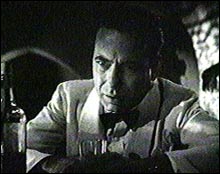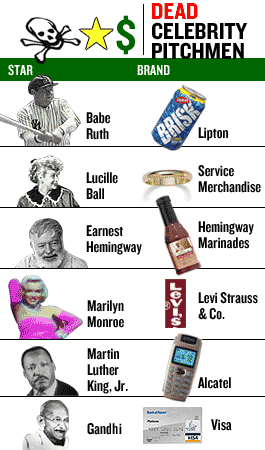NEW YORK (CNN/Money) -
When Frank Sinatra died in 1998, dozens of eulogists predicted "his music will live forever." But nobody foresaw that he would go out on tour again.

Like Mac the Knife, Frank is back in town. In October, a two-week series of aggressively promoted shows at Radio City Music Hall will feature not just the Sinatra songbook but also the man himself.
How's that? Technology, of course.
The event's producers plan to combine advanced audio/video gadgetry with elaborate staging and live musical accompaniment. Result: Sinatra concerts five years after his demise.
About 85,000 tickets will be available for the 14 performances, at prices that range from $40 to $95 (plus a small number of more expensive VIP seats for the swells). Factor in sales of t-shirts, CDs, and other concessions, and the entire two-week run could gross $7 million or more.
The shows represent the latest, most ambitious example of a growing trend in show business and marketing. Dead people are being used to sell everything from beer to vacuum cleaners to concert tickets at $95 a throw.
The late greats boast clearly defined public images, according to Mark Roesler, CEO of CMG Worldwide, a leader in the field of licensing deceased celebrities.
"These are people who have withstood the test of time," he says.
Dancing with a Devil
In the 1983 film, "Zelig," Woody Allen spliced together scenes of live actors with archival footage of historical figures to create a new film making technique.
 |
|
| Of all the neo-colonial interiors in the world, she had to walk into mine! |
Since then, the concept has been copied and expanded upon, in movies like "Forrest Gump" as well as dozens of TV commercials.
In 1996, John Wayne became a pitchman for Coors, despite having died in 1979. A year later, Fred Astaire began dancing with a Dirt Devil vacuum cleaner.
Today, it has become routine to blur the living and the dead. From Babe Ruth to Jackie Gleason, the list of deceased pitchmen stretches almost to eternity.
Hemingway hawks a line of marinades; Bogart flogs furniture for Thomasville, as the anchor of a $20 million ad campaign.

The dead offer a constancy that, say, Kobe Bryant does not. "There are few unknown factors going forward," says Roesler. "There's very little risk of surprises."
To product marketers, predictability is worth money. Licensing fees range from a few thousand dollars for lesser-known people to six figures or more for pop-culture icons. The estate of Marilyn Monroe, for example, earned an estimated $7 million last year.
Nothing is sacred. In one commercial that aired in Europe, Visa used Gandhi to target college kids (he was shown teaching philosophy). In another spot, Martin Luther King, Jr., sold telecom equipment for Alcatel.
It's fortunate that Moses, Jesus and Mohammed have so far been spared, though it may only be for lack of good video.
The Sinatra spectacular
Once advertisers began to grasp the value of the dead, it was only a matter of time before stars would be "brought back" to give performances.
 |
|
| The King made $37M last year |
Last year in London, Orson Welles became a TV star again. The late actor's mellifluous voice was dubbed over the image of a live actor impersonating Welles, to create a "new" presenter for a show, "The Black Museum." The producers spent about $7 million to make 13 episodes, according to Variety, including an unspecified licensing fee to use Welles.
The new Sinatra production will be a much bigger spectacle.
The event will have all the razzle-dazzle of modern Broadway: it will feature a 40-piece orchestra fronted by jazz star John Pizzarelli, the Rockettes, even a gospel choir.
The star will be Old Blue Eyes himself. Video images of the singer will be projected onto three-dimensional screens as his recorded voice plays over the sound system.
A process known as rotoscoping allows the producers to black out other background imagery in each video frame, and then project a solo Sinatra across a series of moveable 3-D panels. The effect is said to be lifelike, as if the singer were moving about the stage as he croons.
"Our audiences will feel like they are experiencing Sinatra's life first hand," said Des McAnuff, creative director.
After seeing a demonstration of the process, "I actually got a little teary-eyed," said Desiree Fish, a spokeswoman for American Express, which is sponsoring the show.
Amex has high hopes for the production -- and not because they're targeting blue-haired nostalgists. Fish says the company hopes this production will appeal to younger audiences as well as older ones.
"We're always trying to bring the brand into pop culture," she says. "We're trying to attract new fans to Sinatra, and therefore to American Express."
Amex sees Sinatra as a symbol of timeless hipsterism. Though the star was famously no angel in life, association with his eternal masculine cool is reason enough to resurrect him.
Thus far, there are no formal plans to expand the show beyond its initial engagement. But if it's successful, one can envision not just an extended run in New York, but a road show, or a Vegas gig for all eternity.
Who's next? Maybe Elvis, or the entire Rat Pack.
Nobody knows, but this much seems certain: Somewhere in the hereafter, a ticket scalper is smiling.

|

